 Image search results - "Hiroshima" Image search results - "Hiroshima" |

Fukuyama Castle tower
|
|

Sign for Tomonoura. Tomonoura is a National Important Traditional Townscape Preservation District (重要伝統的建造物群保存地区).
|
|

Fukuyama Castle tower
|
|

Ferry between Tomonoura and Sensui island.
|
|

View from castle tower
|
|
|
|

Fukuyama Castle from the train
|
|

Bentenjima island near Tomonoura.
|
|

Fukuyama Station (shinkansen)
|
|
|
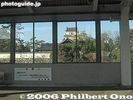
Fukuyama Station (shinkansen)
|
|
|
|

Fukuyama Station (shinkansen)
|
|
|

Fukuyama Station (shinkansen)
|
|
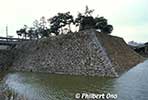
Mihara Castle tenshu main tower foundation and moat. No buildings remain.
|
|

A park on top of the Mihara Castle site.
|
|

Entrance to Hiroshima-Nagasaki photo exhibition 広島・長崎原爆写真展の入口
|
|

Hiroshima photos 広島原爆写真
|
|

Hiroshima panorama photos by Shigeo HayashiThe exhibition room was divided in half by this panel. The right side was for Hiroshima, and the left side for Nagasaki.
|
|

Video monitor showing Hiroshima
|
|

Sadako and her origami cranesBased on a story of a girl named Sadako who was exposed to the atomic bomb in Hiroshima. She was told that if she folded 1,000 paper origami cranes, she would be granted a wish. But she died at age 12 even after folding over 1,000 paper cranes.
|
|

Nagasaki photos by Yosuke Yamahata 山端庸介が原爆投下翌日の写真を撮ったYosuke Yamahata was an Imperial Army photographer who was ordered to go to Nagasaki to photograph the after effects of the atomic bomb. He and two others, a writer and an artist, arrived in Nagasaki the morning after the bomb was dropped. Yamahata went on to capture over 100 extraordinary images of the devastation, people who survived, people helping the wounded, and the inevitable corpses.
山端庸介(1917−66)は陸軍報道カメラマンとして原爆投下翌日の長崎に入り,100枚以上の非常に貴重な歴史的の写真を撮った。長崎原爆資料館にも大きく展示されている。
|
|

Nagasaki photos by Yosuke Yamahata. 写っている人物の当時の状況が詳しく語っています。In 1995, NHK, Japan's leadning TV station, successfully identified some of the survivors pictured in Yamahata's photographs. They even interviewed some of them who were still living. They aired a special TV program and published a book about the extraordinary stories of the survivors.
Those stories have been summarized into Italian for the photo captions in this exhibition.
写っている人物の当時の状況が詳しく語っています。10年前にNHKの取材班が山端庸介の原爆写真に写っている人物の名前とか所在を調べてまだ生きている何人かとインタービューが成功。それが、テレビ番組と本「NHKスペシャル 長崎 よみがえる原爆写真」になって大変感動しました。(テレビ番組も昨年8月に再放送された。)
そのNHK Special番組と本を参考してこの新しい写真集の写真説明文を書きました。イタリア語になっていますが、それぞれの写真を今まで外国語で詳しく説明されたことないのです。被爆者の感動的の話しをもっと海外にも伝いたいのです。
|
|

Nagasaki photos by Yosuke Yamahata
|
|

Nagasaki photos by Yosuke Yamahata
|
|

Nagasaki photos and origami corner 折り紙コーナーVisitors were encouraged to fold a paper crane.
|
|

Panel for exhibition credits クレジットRossella Menegazzo and Philbert Ono were co-curators of the photo exhibition.
イタリア側でこの展覧会と図録のコーディネートをしているRossella Menegazzoさんは、ちょっと古い友人です。彼女は素晴らしい頑張りやさん。まだベネチア大学の学生のとき、夏休みに来日して僕と会いたいと言われて都内のピザ屋(彼女のバイト先)で初めて会ってあげた。
「卒業論文のため、日本人の写真家を研究したい!」と言い出してびっくりしたよ。「木村伊兵衛か土門拳、どっちがいいと思う?」と聞かれても答えないよ。(結局、土門拳になった。)しかし、参考書はほとんど日本語で英語の参考書も(僕のHP以外)非常に少ないと指摘した。でも3年後、なんとイタリア語で土門拳の論文が完成された。これは、イタリア国内で史上初の日本人写真家の論文である。ということは、彼女が日本語も勉強して読めるようになったの。凄いでしょう。
で、話しがまだ続く。彼女の草分けの論文のおかげで大学の後輩も二人、三人が日本の写真家の論文を書いたりしているの。その後輩たちにも僕ができる限り参考書など送っています。(向こうは喜ぶね。)でも、その学生さんが日本人の写真家を論文のためにインタービューしようとすると拒否されることがある(例えば奈良原 一高)。それを聞くと僕はとても恥ずかしい気持した。一方、森山大道の論文を書いた学生が本人とのインタービューが成功した。彼女がとても喜んでいたそうです。(大道さん、ありがとう。)
|
|

Nagasaki exhibition catalog: Yosuke Yamahata-Nagasaki 山端庸介の新しい写真集兼図録This book shows all of Yosuke Yamahata's photos of Nagasaki, including the the 100+ photos of Nagasaki taken on the day after the bomb was dropped. The book includes a photo which has never been published in a book. Many detailed captions about the people identified in the photos are also included. Language is Italian. Order from PhotoGuide Japan's iStore.
山端庸介(1917−66)は陸軍報道カメラマンとして原爆投下翌日の長崎に入り,100枚以上の非常に貴重な歴史的の写真を撮った。長崎原爆資料館にも大きく展示されている。
過去に山端庸介の写真集が国内外に出版されたことあるけど、撮った写真の一部しか紹介されていませんでした。今回の新しい写真集は、山端庸介の長崎関係の全集の写真集とも言えます。本に出版されたことない写真もあります。1946年に撮った写真もあります。
そしてもう一つの大きな特徴は、説明文。写っている人物の当時の状況が結構詳しく語っています。10年前にNHKの取材班が山端庸介の原爆写真に写っている人物の名前とか所在を調べてまだ生きている何人かとインタービューが成功。それが、テレビ番組と本「NHKスペシャル 長崎 よみがえる原爆写真」になって大変感動しました。(テレビ番組も昨年8月に再放送された。)
そのNHK Special番組と本を参考してこの新しい写真集の写真説明文を書きました。イタリア語になっていますが、それぞれの写真を今まで外国語で詳しく説明されたことないのです。被爆者の感動的の話しをもっと海外にも伝いたいのです。
|
|

From Hiroshima Station, it takes about 35 min. to Hiroshima Port via streetcar.
|
|

Hiroshima Port.
|
|

Hiroshima Port.
|
|

Hiroshima Port as seen from a dock.
|
|

Hiroshima Port.
|
|
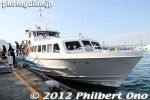
Boat for Etajima island. From Hiroshima Port, it takes about 25 min. to Etajima's Koyo Port, closest to the Naval Academy.
|
|
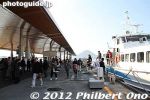
Hiroshima Port.
|
|

Boat for Etajima island, a short boat ride from Hiroshima Port.
|
|

Leaving Hiroshima Port for Etajima island. This is a cargo ship for vehicles called Genuine Ace.
|
|

Etajima island in view.
|
|
|
|
|

Etajima also has shipbuilding facilities.
|
|
|
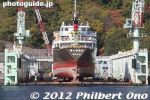
Shipbuilding on Etajima, Hiroshima.
|
|
|
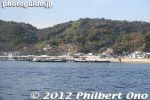
Approaching Etajima's Koyo Port.
|
|

Etajima's Koyo Port.
|
|

From Koyo Port, take a bus for a 5-min. ride to the Naval Academy. Or take a taxi if a bus is not available.
|
|

Entrance to the Naval Academy on Etajima.
|
|

Reservations are not required, but you have to get there and sign up 5 min. before the 90-min. tour starts.
|
|

The Naval Academy conducts free guided tours of the school 3 or 4 times a day. The tour takes you around the campus and allows you to enter a few of the imposing buildings.
|
|

Map of the Naval Academy or Japanese Maritime Self Defense Force First Service School (海上自衛隊第1術科学校).
|
|

You cannot tour the Naval Academy on your own. You have to join the guided tour. There is a dress code: No miniskirts or provocative clothing by women.
|
|

Two Naval Academy students served as our tour guide.
|
|

Ceremonial Hall. Built in 1917 and designed for holding ceremonies and moral education. One of the few buildings which we could enter. Etajima, Hiroshima.
|
|

Inside the Ceremonial Hall. It can fit 2,000 people.
|
|

Stage inside the Ceremonial Hall.
|
|
|

Ceremonial Hall
|
|

The lights look like a ship's wheel on the ceiling of the Ceremonial Hall.
|
|

The academy's pine tree trunks grow straight up. They say that even the pine trees stand at attention at the school.
|
|

Stand for gatherings.
|
|

The academy's most distinctive building is this Students’ Hall dubbed the "Red Brick Building." We weren't allowed to go inside. Etajima, Hiroshima.
|
|

Built in 1893 and used for classrooms and living quarters for students. Today, it is part of the Officer Candidate School and used as classrooms and students' living quarters. Etajima, Hiroshima.
|
|
|
|
|
|
|
|
|
|

Students' Hall west wing. Built in 1938, it is used as the main students’ hall of the First Service School.
|
|

Students' Hall west wing. We weren't allowed to enter this building. The Academy also has female students, but after graduating they do not serve on navy ships. They work only on land.
|
|
|
|

Front Pier. This is considered the school's front gate instead of the gate on land. Officer Candidate School graduates are sent off here by school staff and a military band and transferred to a training fleet anchored offshore in Etauchi inlet.
|
|

Training boats
|
|
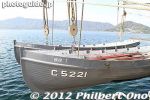
Training boats
|
|

Battleship gun, life-size.
|
|

The Gun turret was a part of the main gunnery system of Battleship Mutsu and was transferred to Imperial Naval Academy for use as a study aide in 1935.
|
|

Gun turrets
|
|

Projectile of a "Mutsu" class battleship.
|
|

Torpedoes
|
|
|
|

Naval History Museum on Etajima. Built in 1936, the museum is substantial with detailed exhibits tracing Japan's naval history (including the Pearl Harbor attack).
|
|

The Naval History Museum on Etajima has this outdoor display of one of the five midget submarines used in the Pearl Harbor attack.
|
|

One of the five midget submarines used in the Pearl Harbor attack. On display at the Naval History Museum on Etajima island, Hiroshima.
|
|

Torpedo bay of midget submarine used in Pearl Harbor attack.
|
|

The midget sub displayed here was found in 1960 off Keehi Lagoon east of Pearl Harbor's entrance. The sub had been damaged by a depth charge attack and abandoned by its crew before it could fire its torpedoes.
|
|

It was subsequently salvaged and restored for display at Etajima in 1962. The front part of the sub was severed, so the front part was reconstructed by a Kure shipbuilder for this display.
|
|

Midget sub's conning tower and periscope. The sub had only two crew members.
|
|

Midget sub's rudder and propeller.
|
|

They eventually found all five subs (the fifth one was finally found in 2009) used at Pearl Harbor. Two of them are on display. One of them is here and the other is at the National Museum of the Pacific War in Fredericksburg, Texas.
|
|
|
|
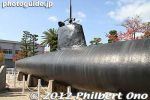
This midget sub was transported by boat from Pearl Harbor to Yokosuka (Kanagawa Pref.), then to Etajima in 1961.
|
|

About this midget sub: Length: 23.9 meters, Weight: 46 tons, Inner diameter: 1.85 meter, Underwater speed: 19 knots (600 horsepower)
|
|
|
|

Behind the midget sub used in Pearl Harbor, another different type of midget sub is displayed.
|
|
|
|
|
|
|
|
|

A projectile used by battleship Yamato during WWⅡ.
|
|
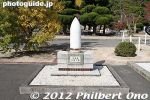
Projectile used in Japan-China War in 1894.
|
|
|

Last stop on the tour was the Etajima Club where there is a gift shop, restaurant, and this small museum on the 2nd floor.
|
|
|

Japanese navy rising sun flag
|
|

Models of navy warships.
|
|
|
|
|
|

Etajima Club exhibition room.
|
|

Back at Koyo Port to board this boat for Kure, across the Seto Inland Sea.
|
|

Koyo Port on Etajima, Hiroshima.
|
|

Our boat for Kure from Etajima island.
|
|

Leaving Koyo Port, Etajima.
|
|
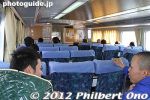
Inside our boat to Kure from Etajima.
|
|

Kure across the Inland Sea.
|
|

Kure is a short boat ride from Etajima.
|
|

On the way to Kure.
|
|

A few islands in the Seto Inland Sea on the way to Kure. In Kure, we visited the Yamato Museum.
|
|

Mt. Fudekage is 313 meters high and part of the Seto Inland Sea National Park. Great views of Seto Inland Sea and Shikoku from Mihara, Hiroshima.
|
|

From JR Mihara Station, there's a local bus that goes up to Mt. Fudekage taking 7 min. Otherwise, it's a 50-min. hike from JR Sunami Station (JR Kure Line).
|
|
|

Looking east.
|
|

View of Seto Inland Sea from Mt. Fudekage in Mihara, Hiroshima.
|
|

View of Seto Inland Sea from Mt. Fudekage in Mihara, Hiroshima. you can see Kosagi in the foreground, Sagi, and Hoso islands. In the distance on the right is Innoshima and part of the Shimanami Kaido bridge connecting Shikoku (Imabari) and Hiroshima.
|
|

Mt. Fudekage has a lookout deck for great views.
|
|

View of Seto Inland Sea from Mt. Fudekage in Mihara, Hiroshima.
|
|
|
|
|

View of Seto Inland Sea from Mt. Fudekage in Mihara, Hiroshima.
|
|
|

View of central Mihara (area around Mihara Station) from Mt. Fudekage in Mihara, Hiroshima.
|
|

View of central Mihara (area around Mihara Station) from Mt. Fudekage in Mihara, Hiroshima.
|
|

JR Sunami Station (JR Kure Line) is the closest to Mt. Fudekage. Then it's a 50-min. hike up. 須波駅
|
|

Hiroshima Castle tower was rebuilt in 1958 after World War II. The original castle was destroyed by the atomic bomb in Aug. 1945.
|
|
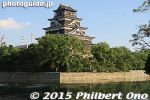
Hiroshima Castle tower is a museum of Hiroshima's history before World War II.
|
|

The moat and walls are quite expansive.
|
|
|
|
|

Hiroshima Castle
|
|
|

Hiroshima Castle towerRebuilt after World War II.
|
|

Hiroshima Castle in the early 1900s from a vintage postcard.
|
|

In 1994, this gate and a yagura turret in the ninomaru were re-constructed out of wood.
|
|
|

Ninomaru
|
|
|

Hiroshima Castle ninomaru turret was reconstructed in 1994.
|
|

You can go inside the reconstructed ninomaru structure.
|
|
|
|
|
|
|
|
|

Inside the ninomaru Yagura turret. Cannot go upstairs.
|
|
|
|

Part of Hiroshima Castle stone wall is black due to the atomic blast.
|
|
|
|
|
|
|
|
|

Street car stop nearest to the Hiroshima Peace Memorial Park. Hiroden Genbaku Dome-mae Station. Hiroshima is one of the few Japanese cities which still has street cars.
|
|

Right near the streetcar stop is the Atomic Bomb Dome or A-Bomb Dome (原爆ドーム). I visited in fall 2012.
|
|

Built in 1915, it was the Hiroshima Prefectural Industrial Promotion Hall.
|
|

The atomic bomb fell almost directly above this building on Aug. 6, 1941 at 8:15 am.
|
|

The Atomic Bomb Done was designated a UNESCO World Heritage Site in 1996.
|
|

I think all Americans visiting or living in Japan should visit Hiroshima. It's not about who's to blame for what happened here in Aug. 1945. It's about a major event in human history and a reminder of man's fatal flaws.
|
|

Notice the steel braces to reinforce the building.
|
|
|
|
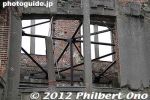
Notice the steel braces to reinforce the building.
|
|
|

We can get quite close to the building, but it is fenced off so we cannot enter it.
|
|
|
|
|
|
|
|
|
|
|
|

Hiroshima Atom Bomb Dome
|
|
|
|

Monuments abound in the Peace Park. In the background is Aioi Bridge, the original target of the atomic bomb.
|
|
|
|

View from Aioi Bridge.
|
|
|
|
|
|
|
|
|
|
|
|
|
|

Atomic Bomb Dome
|
|
|
|
|
|
|
|
|

Peace Clock Tower
|
|

Peace Clock Tower
|
|

Peace Bell. Peace Bell. Anyone can ring it for free.
|
|

About the Peace Bell
|
|

Hiroshima Peace Bell
|
|

Hiroshima Peace Bell with atom symbol on the sweet spot.
|
|
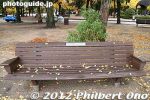
Donated benches.
|
|

Donors of benches.
|
|
|

Children's Peace Monument dedicated to the memory of the children who died as a result of the bombing.
|
|

Children's Peace Monument
|
|

Children's Peace Monument before they built origami crane shacks around it.
|
|

Bell in Children's Peace Monument.
|
|
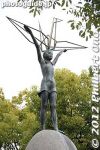
Children's Peace Monument, Hiroshima
|
|

Rear of Children's Peace Monument, Hiroshima.
|
|

About the Children's Peace Monument.
|
|

Shacks of origami paper cranes folded by many students from all over.
|
|

Very colorful and incredible designs.
|
|

There's a sign indicating where you should hang your origami cranes.
|
|
|
|

Hiroshima
|
|

Pictures made of origami at Hiroshima Peace park.
|
|

Another building that survived the atom bomb. Now a rest house and tourist information center. Hiroshima.
|
|

About the rest house.
|
|

This is where the Hiroshima Peace Memorial Ceremony is held on Aug. 6 in the morning. The service is open to the public for free and you can sit if you get there early enough in the morning. Otherwise, you can stand in the back amid the sweltering heat.
|
|

Memorial Cenotaph
|
|
|

Memorial Cenotaph
|
|

Peace Flame aligned with the Cenotaph and Atomic Bomb Dome.
|
|

Memorial Cenotaph
|
|

Memorial Cenotaph
|
|
|
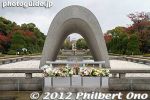
The Peace Park's focal point is this Memorial Cenotaph. It stores the names of all of the people killed by the bomb. The monument frames the Peace Flame and the A-Bomb Dome in a straight line.
|
|

One of the Japan's best-designed memorials.
|
|

Atomic Bomb Dome as seen from the Cenotaph.
|
|
|
|
|